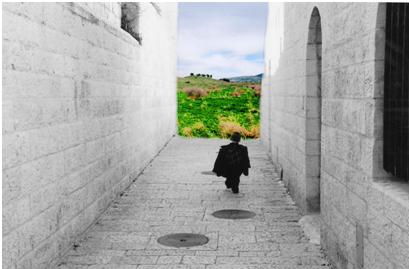[Originally written for my HUC blog but appearing here first!]
[Also published on the Reform Movement's blog!]
Chag urim sameach - happy Festival of Lights!
For the past two months, four classmates and I have been participating in Rav Siach, an interdenominational discussion group for rabbinical students through a pluralistic education center in Jerusalem. We meet every Tuesday night for two and a half hours, and we discuss and debate issues like commandedness, the role of the rabbi, and denominational distinctions. There are about a dozen participants with three facilitators, and participants come from Reform, Conservative, Reconstructionist, “orthodox,” and non-denominational backgrounds.
One of the most intense components of Rav Siach has been our recent Shabbaton, which began when we departed from Jerusalem at 7:15 am on Friday morning for the Arbel. The Arbel is a plateau overlooking Lake Kinneret, Sfat, Tiberias, and the coastal plain. From so high up, one can see for miles in any direction, and the views were simply stunning.

Rav Siach participants at the Arbel.
The wife of one of our facilitators is a tour guide in the Arbel, and she led us through paths down the side of the Arbel and around the face of the cliff. We rested in the abandoned caves that had been inhabited by the last remnants of the Hasmonean Dynasty that had gained control of the land of Israel following the events commemorated by Hanukkah, and we read the historical account of their eventual defeat in these very hills. Afterward, we climbed back up the cliff, gripping iron handholds and stealing final glimpses of the plains and hills laid out before us. When we reached the top, we ate our packed lunches and headed to the hostel/conference center where we’d be spending the night.
The actual hours of Shabbat were fascinating on many levels. First of all, there were a number of interesting lessons offered by our peers. Some of the topics included a comparison of the parsha with a selection from Homer’s Odyssey, Reform Responsa (religious/legal decisions in the Reform movement), and the recent ruling in the Conservative movement to allow for the ordination of openly gay rabbis. We walked on Saturday afternoon to the Kinneret Cemetery, where several influential figures in early Israeli history, including the poet Rachel, the songwriter Naomi Shemer, and the Zionist labor leader Berl Katznelson are buried. And, of course, the food was plentiful and terrific!
Two particular events especially defined the scope and depth of the Shabbaton for me. The first occurred on Friday night, when we walked to our assigned room to pray together. Upon arrival, we discovered that the light was off, and to turn it on would be a violation of the rules of Shabbat in the eyes of our observant participants. As this value isn’t part of my own Shabbat practice, I thought I could fix the situation by simply turning on the light in the room. I knew that it was unacceptable to ask someone to turn a light on for you, so I quickly walked to the room and flipped the switch on without saying a word. What followed was a wholly unique experience.
Immediately, the group had transformed. Everyone was in shock. What had I done? Although I didn’t know this at the time, it’s additionally not allowed for one who observes strict laws of Shabbat to make use of the result of a fellow Jew’s breaking those laws. In other words, though I had tried to make the room suitable for our use, I had actually made it entirely unkosher.
I’ve come head-to-head with halacha before, but this was the first time that I had really affected people that I cared about. Words were exchanged, apologies were made, and discussion ensued. This certainly serves of an example of the principle that being told something doesn’t make up for experiencing it firsthand. Never before had I felt so much access to the world of halacha as when I entered that world and shattered it for others. It was a painful lesson but an important one, and certainly the most important to me over the course of the Shabbaton.
On the other side of the spectrum, the spiritual high for me came on Shabbat morning. Our non-denominational rabbinical student led us in meditative morning blessings, and the combination of singing and silence launched me into a spiritual experience. While our voices had been in debate and discussion, not until this moment were they in harmony. I felt our small community coalesce into a praying body, and I was proud and delighted to be a part of it.
In my eyes, the Shabbaton was a terrific success and showed that pluralistic Shabbat experiences may not be easy but they can absolutely be transformative. Many of the Rav Siach participants felt a renewed interest in such programs, and I believe that we’re all better equipped to lead and learn in such environments in the future. While I’m disappointed that our official group will be coming to a close in a few weeks, I look forward to continuing my relationship with these future colleagues and continuing to learn from them for years to come.

No comments:
Post a Comment